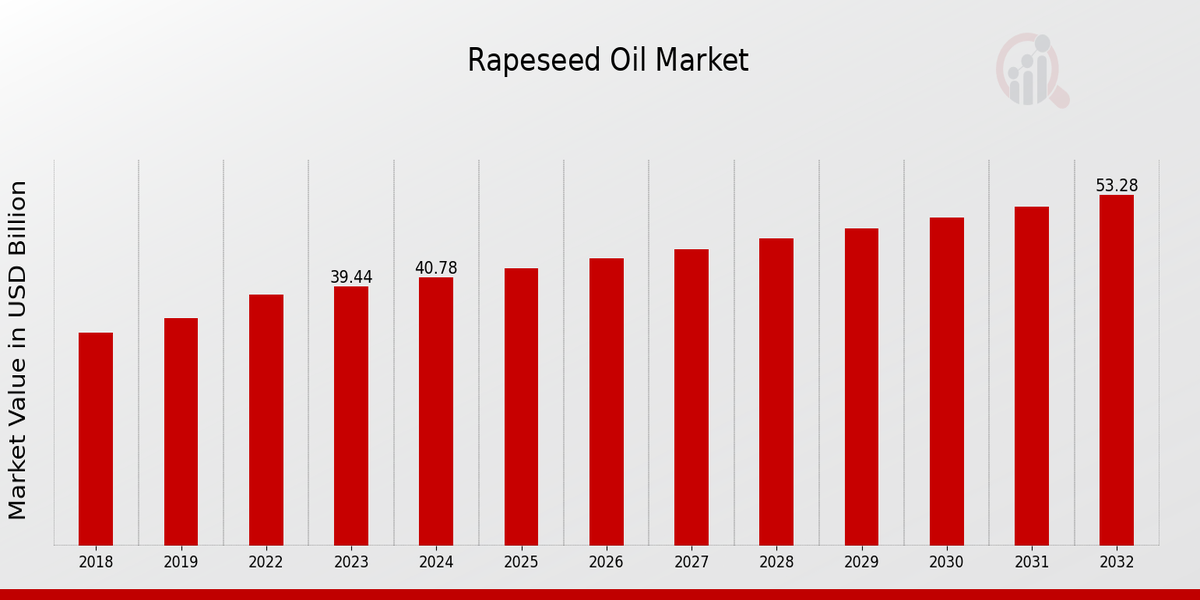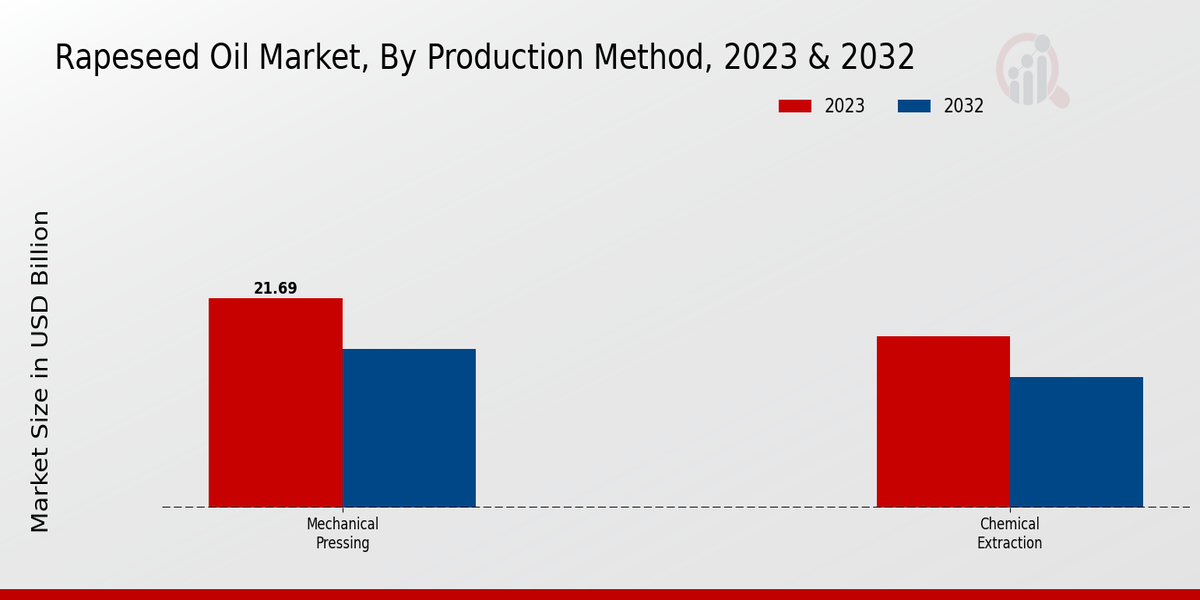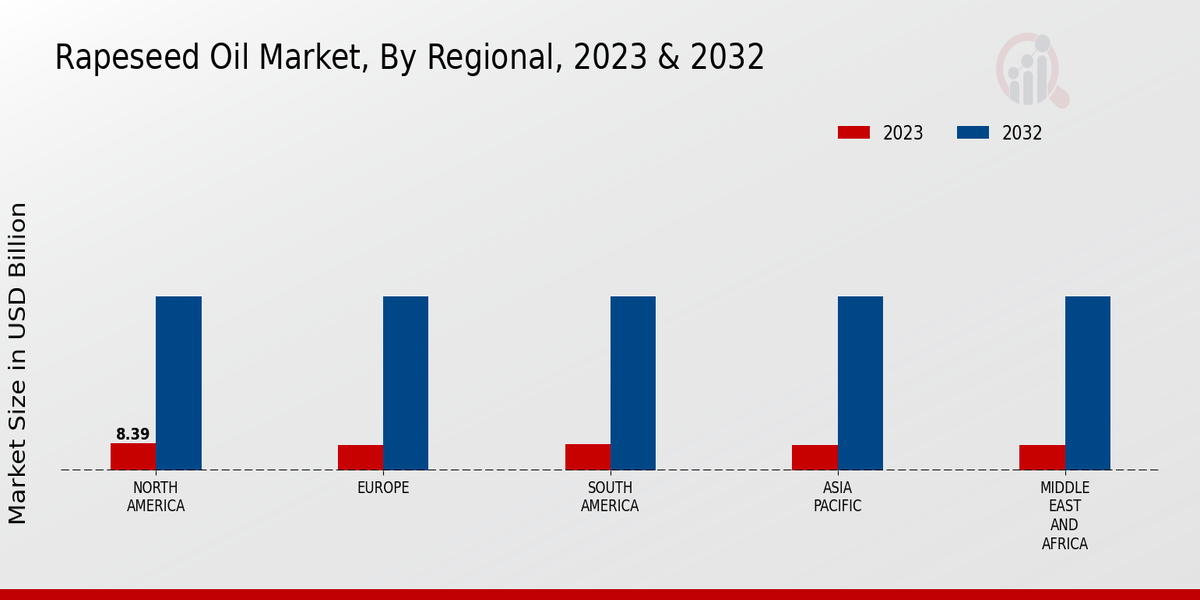Global Rapeseed Oil Market Overview
Rapeseed Oil Market Size was estimated at 38.14 (USD Billion) in 2022.The Rapeseed Oil Industry is expected to grow from 39.44(USD Billion) in 2023 to 53.3 (USD Billion) by 2032. The Rapeseed Oil Market CAGR (growth rate) is expected to be around 3.4% during the forecast period (2024 - 2032).

Source: Primary Research, Secondary Research, MRFR Database and Analyst Review
Key Rapeseed Oil Market Trends Highlighted
The rapeseed oil market is poised for sustained growth due to rising demand for healthy oils and fats. Increasing health consciousness among consumers is driving the preference for rapeseed oil, owing to its high content of monounsaturated and polyunsaturated fatty acids.Key market drivers include the expanding food and beverage industry, particularly in emerging economies, where demand for rapeseed oil as a cooking and frying medium is increasing. Additionally, the rising use of rapeseed oil in biofuel production is contributing to market growth. Opportunities for exploration lie in the development of value-added rapeseed oil products, such as functional oils and specialty blends, to cater to the growing consumer demand for healthier and more sustainable options.Recent trends in the rapeseed oil market indicate a shift towards sustainable production practices, such as using non-GMO seeds and adopting environmentally friendly farming techniques. Moreover, technological advancements in oil extraction and refining processes are leading to improved efficiency and yield, further driving market growth.
Rapeseed Oil Market Drivers
Rising Demand for Rapeseed Oil in the Food Industry
Rapeseed oil is becoming more popular in the food industry. The product’s general beneficial qualities are that it comprises a range of monounsaturated and polyunsaturated fatty acids, which are particularly good for the health of human hearts and serotonin relations in particular. Rapeseed oil also contains omega-3 acid, and it’s a great way to maintain human beings’ developed and undeveloped brains, considering these fatty acids are the very matter they are built from.The growing tendency of healthy and organic food items in consumption allows for predicting the further increased pace in the expansion of the rapeseed oil market. A surge in the market is also conditioned by rapeseed oil being better priced and less expensive than its usual counterparts. The Rapeseed Oil Market Industry is expected to show a marked upsurge over the forecast period, owing to mounting market demand in the food industry.
Growing Biodiesel Production
Rapeseed oil is one of the main feedstocks required for biodiesel production. Biodiesel, a renewable and sustainable alternative fuel to fossil diesel, is currently gaining its underpinning market around the globe and is one of the key drivers responsible for the growing demand in the rapeseed oil market. Governments around the globe are encouraging and promoting biodiesel usage to reduce their dependence on fossil fuels and to successfully meet the goals for less environmental pollution.Based on this reason, the Rapeseed Oil Market Industry is likely to grow significantly over the forecast period as biodiesel production is growing significantly.
Increasing Health Consciousness
As more and more consumers are health-conscious and on the lookout for healthier options than traditional cooking oils, rapeseed oil is a good source of healthy fats and low saturated fat but a reasonable source of vitamins E and K. The awareness of health consciousness among the masses is leading to the growth of the rapeseed oil market. Therefore, the Rapeseed Oil Market Industry is poised to grow in the forecast period.
Rapeseed Oil Market Segment Insights
Rapeseed Oil Market Production Method Insights
The Rapeseed Oil Market is divided into mechanical pressing and chemical attraction production. Mechanical pressing is a traditional production method that involves crushing the seed and squeezing it as much as possible. It is the most suitable method for the production of high-quality rapeseed oil with a distinctive flavor and aroma. However, the yield of this method is lower than that of the second method described in this article. In addition, pressing is generally more labor-intensive and time-consuming, so it does not provide the same level of productivity as chemical extraction.Chemical extraction means the dissolution of oil in a substance that is then extracted. The most common solvent for oil is hexane.
This method requires fewer human resources and takes relatively less time compared to mechanical pressing. According to the report data, in 2023, the mechanical pressing of rapeseed oil was approximately 40% of revenue, and chemical extraction accounted for the remaining 60%. Over the past years, the mechanical pressing of rapeseed oil has become the leading segment since it is preferred by manufacturers due to the increased consumer demand for high-quality rapeseed oil.The mechanical pressing of rapeseeds will dominate the market for the foreseeable future, as it is expected to gain popularity. Nevertheless, the chemical attraction of rapeseed oil is expected to grow at a good pace because it is more efficient and cheaper to produce.

Source: Primary Research, Secondary Research, MRFR Database and Analyst Review
Rapeseed Oil Market Usage Insights
The most significant part of the Rapeseed Oil Market in 2023 is the Usage segment, defining the market dynamics. This year, the Food and Beverage sector took the leading position. Rapeseed oil has a neutral taste and reaches a high smoke point, which allows it to be an ingredient in a wide spectrum of dishes. Some countries prefer rapeseed oil to other types of fats and cooking oils, such as in Europe and in the Asia-Pacific region. This segment is also growing as a result of increased demand for food that is processed and/or packaged.The other application of rapeseed oil that affects the market is the production of biofuels. The product serves as a more environmentally friendly source of biodiesel compared to fossil fuels, as it allows to minimize greenhouse gas emissions. Thus, this part of the Usage segment of rapeseed oil consumption is stimulated by governmental initiatives and ecology concerns. Also, there is a share of the market taken by various industrial applications. Considering its exceptional properties that make it a highly prevailing cooking oil, rapeseed oil is also highly resistant to oxidation and is able to remain liquid at low temperatures.This factor allows us to effectively apply the oil to various industrial products, such as paints, lubricants, and cosmetics in particular. Since the manufacturing industry in developing countries is growing, the demand for rapeseed oil for industrial purposes is also expected to grow in upcoming years.
Rapeseed Oil Market Grade Insights
The Grade segment of the Rapeseed Oil Market is categorized into Cold-Pressed, Refined, and Deodorized. Among these, the Refined grade held the largest market share in 2023, accounting for approximately 60% of the Rapeseed Oil Market revenue. Refined rapeseed oil is produced through a process that removes impurities, resulting in a neutral taste and color, making it suitable for various culinary applications. The Cold-Pressed grade is gaining popularity due to its minimally processed nature and perceived health benefits. Deodorized rapeseed oil is processed to remove unwanted odors, making it ideal for use in food products where flavor and aroma are important.The Rapeseed Oil Market is expected to continue to grow in the coming years, driven by increasing demand from the food and beverage industries, as well as the growing awareness of its health benefits.
Rapeseed Oil Market Certification Insights
The certification segment of the Rapeseed Oil Market is anticipated to witness significant growth in the coming years. The rising consumer demand for certified products, such as organic, non-GMO, and fair trade, is driving the growth of this segment. Organic rapeseed oil is gaining popularity due to its perceived health benefits and environmental sustainability. According to industry estimates, the global organic rapeseed oil market is projected to reach a market value of 1.2 billion USD by 2027. Non-GMO rapeseed oil is also gaining traction, driven by consumer concerns over genetically modified organisms (GMOs).The market for non-GMO rapeseed oil is expected to grow at a CAGR of 4.5% over the forecast period. Fairtrade rapeseed oil promotes fair wages and working conditions for farmers, ensuring sustainability throughout the supply chain. The growing awareness of ethical consumption is boosting the demand for fair trade rapeseed oil, contributing to the growth of the certification segment in the Rapeseed Oil Market.
Rapeseed Oil Market Regional Insights
The Rapeseed Oil Market is segmented into North America, Europe, APAC, South America, and MEA. Among these regions, Europe dominated the market in 2023, accounting for a revenue share of around 37.9%. The region's dominance can be attributed to the high consumption of rapeseed oil in countries such as Germany, France, and the United Kingdom. Moreover, the presence of major rapeseed oil producers in Europe further strengthens the region's position in the global market. The APAC region is expected to witness significant growth in the Rapeseed Oil Market during the forecast period.The growing demand for rapeseed oil in countries such as China, India, and Japan is driving the market growth in this region. The increasing population and rising disposable income in these countries are also contributing to the demand for rapeseed oil. North America and South America are expected to have a moderate growth rate in the Rapeseed Oil Market during the forecast period, while MEA is expected to have a relatively low growth rate.

Source: Primary Research, Secondary Research, MRFR Database and Analyst Review
Rapeseed Oil Market Key Players And Competitive Insights
Leaders in the industry of the Rapeseed Oil Market are always at the forefront pursuing what has never been done. To be well-positioned in their competitive field, the best market Rapeseed Oil Market companies invest more in Research and Development. This investment has so far enabled the leading Rapeseed Oil Market companies to develop well-timed and fully vital innovations. Leading companies in this Rapeseed Oil Market are keen to develop innovations that will respond to the fast-evolving consumer preferences. The rapeseed oil market is experiencing a similarly rapid growth due to the increasing demand for greener and environmentally safe products as well as the aspiration for fame and excitement of the unknown. The presence of aggressive players, such as new entrants and global leaders scheming to expand their territories into various competitive markets, will maintain a similar force for years.The leading competitor of ADM in the Rapeseed Oil Market is ADM. The company has stayed ahead across the globe and is offering a wide range of rapeseed oil products. ADM pursues the delivery of high-quality customers to their customers, and they can consider ADM to be their best first choice. ADM has always been concerned and dedicated to a more sustainable future. Bunge also presents the best competition of ADM in the Rapeseed Oil Market, where Bunge is also recognized for delivering the best rapeseed oil products and operating in more impressive markets. Mainly, Bunge has also engaged in aggressive market expansion. Both ADM and Bunge are fully committed to delivering high-quality products and services no matter how successful they are.
Key Companies in the Rapeseed Oil Market Include
- COFCO Corporation
- ADM
- Louis Dreyfus Company
- Olam International
- ArcherDanielsMidland Company
- Cargill
- Glencore
- CHS Inc.
- LDC
- Mitsubishi Corporation
- Itochu Corporation
- Wilmar International Limited
- Sumitomo Corporation
- Bunge
- Marubeni Corporation
Rapeseed Oil Market Industry Developments
The Rapeseed Oil Market is projected to grow from USD 29.66 billion in 2023 to USD 40.33 billion by 2032, exhibiting a CAGR of 3.4% during the forecast period. Increasing demand for rapeseed oil as a healthier alternative to other vegetable oils, rising consumption in food and beverage industries, and growing biodiesel production are the key factors driving the market growth. Major players in the market include Archer Daniels Midland Company, Bunge Limited, Cargill Incorporated, and Louis Dreyfus Company. Recent news developments include the construction of a new rapeseed oil processing plant in Canada by Cargill and the acquisition of a rapeseed oil refinery in the Netherlands by Bunge. These investments indicate the growing demand for rapeseed oil globally.
Rapeseed Oil Market Segmentation Insights
-
Rapeseed Oil Market Production Method Outlook
- Mechanical Pressing
- Chemical Extraction
-
Rapeseed Oil Market Usage Outlook
- Food and Beverage
- Biofuel Production
- Industrial Applications
-
Rapeseed Oil Market Grade Outlook
- Cold-Pressed
- Refined
- Deodorized
-
Rapeseed Oil Market Certification Outlook
- Organic
- Non-GMO
- Fair Trade
-
Rapeseed Oil Market Regional Outlook
-
North America
-
Europe
-
South America
-
Asia Pacific
-
Middle East and Africa
| Report Attribute/Metric |
Details |
| Market Size 2022 |
38.14 (USD Billion) |
| Market Size 2023 |
39.44 (USD Billion) |
| Market Size 2032 |
53.3 (USD Billion) |
| Compound Annual Growth Rate (CAGR) |
3.4% (2024 - 2032) |
| Report Coverage |
Revenue Forecast, Competitive Landscape, Growth Factors, and Trends |
| Base Year |
2023 |
| Market Forecast Period |
2024 - 2032 |
| Historical Data |
2019 - 2023 |
| Market Forecast Units |
USD Billion |
| Key Companies Profiled |
COFCO Corporation, ADM, Louis Dreyfus Company, Olam International, ArcherDanielsMidland Company, Cargill, Glencore, CHS Inc., LDC, Mitsubishi Corporation, Itochu Corporation, Wilmar International Limited, Sumitomo Corporation, Bunge, Marubeni Corporation |
| Segments Covered |
Production Method, Usage, Grade, Certification, Regional |
| Key Market Opportunities |
Biodiesel Production Food and Beverage Industry Animal Feed Industry Growing Demand in Asia Health Benefits |
| Key Market Dynamics |
1 Increasing demand from the biodiesel industry2 Rising health consciousness3 Improved cultivation techniques4 Government support for sustainable agriculture5 Technological advancements |
| Countries Covered |
North America, Europe, APAC, South America, MEA |
Frequently Asked Questions (FAQ) :
The Rapeseed Oil Market was valued at approximately USD 39.44 billion in 2023 and is projected to reach USD 53.3 billion by 2032, exhibiting a CAGR of 3.4% during the forecast period.
Europe and Asia-Pacific are the dominant regions in the Rapeseed Oil Market, collectively accounting for over 70% of the market share. China is the leading consumer of rapeseed oil, followed by India and the European Union.
Rapeseed oil is primarily used for cooking purposes, but it also has industrial applications. In the food industry, it is used as a cooking oil, salad dressing, and margarine. Industrially, it is used in the production of biodiesel, lubricants, and cosmetics.
Major players in the Rapeseed Oil Market include Archer Daniels Midland Company, Bunge Limited, Cargill, Incorporated, CHS Inc., and Louis Dreyfus Company. These companies hold a significant market share and are involved in the production, processing, and distribution of rapeseed oil.
The growth of the Rapeseed Oil Market is attributed to increasing demand for vegetable oils, rising health consciousness among consumers, and government initiatives promoting the use of biofuels. Additionally, technological advancements in oil extraction and processing are further contributing to market growth.
Challenges faced by the Rapeseed Oil Market include fluctuations in rapeseed production due to weather conditions, competition from other vegetable oils, and regulatory restrictions on the use of biofuels. Additionally, the availability of substitutes and the impact of climate change on rapeseed cultivation pose challenges to market growth.
Emerging trends in the Rapeseed Oil Market include the development of genetically modified rapeseed varieties with improved yield and oil content. Additionally, increasing demand for sustainable and eco-friendly products is driving the adoption of rapeseed oil as a renewable and biodegradable resource.
The outlook for the Rapeseed Oil Market is positive, with steady growth expected over the forecast period. Increasing demand for vegetable oils, coupled with government support for biofuel production, is likely to drive market growth. Furthermore, technological advancements and the development of new applications are expected to create new opportunities in the market.
Key opportunities for growth in the Rapeseed Oil Market lie in expanding into emerging markets, developing value-added products, and investing in research and development to improve rapeseed productivity and oil quality. Additionally, partnerships and collaborations between market players can create synergies and drive innovation.
Potential risks to the growth of the Rapeseed Oil Market include adverse weather conditions affecting rapeseed production, geopolitical uncertainties, and changes in government policies. Furthermore, competition from other vegetable oils and the development of alternative biofuels pose challenges to market growth.

















